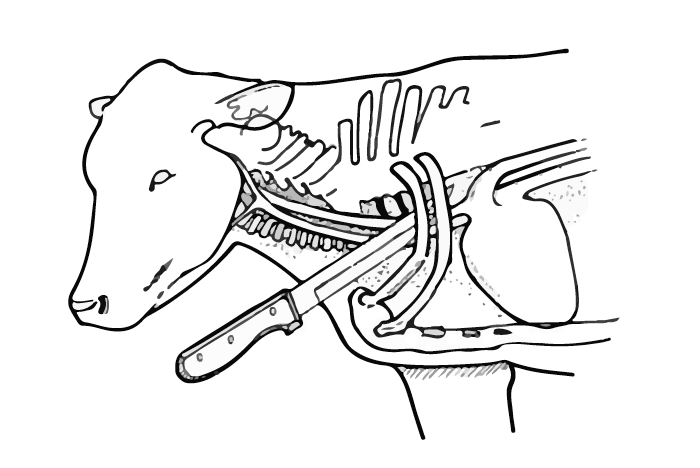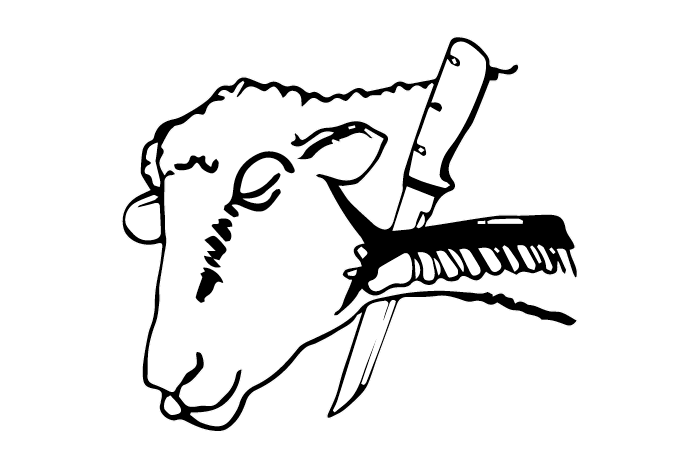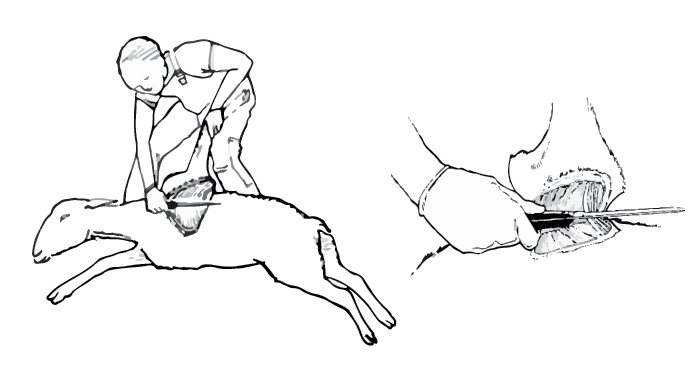Bleeding is also known as bleeding-out or exsanguination. It is achieved by severing major blood vessels with a knife. The most suitable major vessels to be severed are those of the neck, chest or armpit. The procedures are known respectively as the throat cut, armpit cut and chest stick. It is sometimes performed in preparation for necropsy. Exsanguination may make assessment of tissues easier at necropsy by preventing free blood from pooling in cavities.
In sheep and goats, the throat cut may be used as the primary method of euthanasia if a captive bolt or firearm is unavailable. This is severing the carotid arteries with a throat cut completely interrupting the supply of arterial blood to the brain. Pre-injection with xylazine is recommended if available.
The throat cut should not be used as a primary method of killing cattle. In cattle, bleeding is a follow-up procedure, only to be used on unconscious animals after a firearm, captive bolt or blunt trauma have been used. This is because cattle have two different sources of arterial blood supply to the brain: the carotid arteries and the vertebral arteries. The vertebral arteries are enclosed in the spinal canal at the anterior neck and are not severed when the throat is cut.
All three cuts may be used in unconscious animals as a follow-up method to gunshot, captive bolt or blunt trauma.
Site preparation and management is important when bleeding is used in euthanasia. Heavy blood loss may occur for up to two minutes. Care must be taken to ask bystanders to leave and it should not be performed in public view. A well drained area is required to wash away blood.
The knife should have a stiff 15 cm (6-inch) length blade with a non slip handle and finger guard. Boning knives are ideal. It must be sharp. Carry a steel or sharpening stone if multiple animals are to be bled.
The chest stick aims to sever the major vessels extending from the top of the heart, such as the aorta and vena cava. As a follow-up method, it is the preferred method of the three bleeding cuts because all blood flow to the head is stopped immediately once the vessels are cut. The lungs collapse and skin damage is minimal if that is to be salvaged. However, the chest stick can make pathological changes in the chest difficult to assess at necropsy.

Figure 9.3: Diagram showing a chest stick with the knife inserted into the thoracic inlet in the midline of the ventral neck between the first ribs and above the sternum
The heart sits in the bottom-front part of the chest with major vessels extending from top of the heart (Figure 9.3). These vessels are within easy reach of a 15 cm blade inserted into the chest in the midline where the brisket joins the ventral neck. Once the blade is deep inside the chest, a sideways slicing action in one direction and then the other, ensures that the vessels are severed.
The throat cut aims to sever the carotid arteries at the level of the throat, near where the neck joins the head. It may make pathological changes in this area difficult to assess at necropsy. The best method for performing the throat cut is by fully inserting the knife just behind the angle of the jaw beneath the neck bones (Figure 9.4). A knife such as a boning knife with strong, sharp 15 cm blade, a pointed tip and a non-slip handle is essential. This method causes the carotid arteries to be cut during insertion of the knife. An outward cut (directed ventrally) ensures the carotid arteries and jugular veins are severed and also the windpipe.
Other knives may be used but if the knife does not have a sharp point, it will require cutting from the skin inward. Make an inward cut through the skin with the neck extended over the joint connecting the skull with the first neck bone (the atlanto-occipital joint). The skin, windpipe and major blood vessels are each severed in rapid succession. The obvious shortcoming is that the vessels (and hence the blood supply to the brain) are the last tissues to be cut.

Figure 9.4: The throat cut with a knife inserted at the angle of the jaw and cutting outwards to sever the carotid arteries, jugular veins and windpipe
The armpit cut aims to sever the vessels under the arm. It is the preferred method if you wish to avoid damage to throat and chest structures caused by the other
methods. Lift the leg and insert the knife deep into the axilla, severing the large blood vessels (Figure 9.5). The armpit cut should only be used as a follow-up method to a firearm, captive bolt or blunt trauma, and only if the animal is unconscious. A knackery service may refuse to remove the carcase because of the damage to the skin.

Figure 9.5: The armpit cut. The front leg is raised and a knife inserted into the armpit and the brachial artery and vein severed